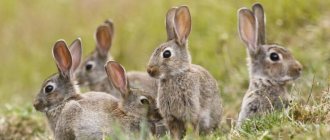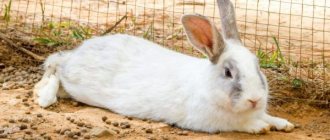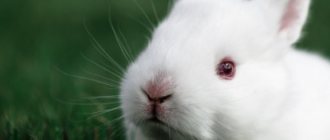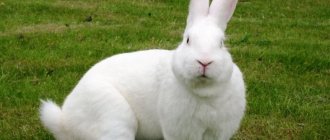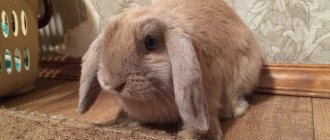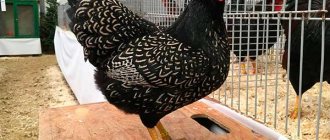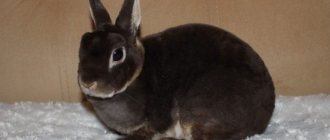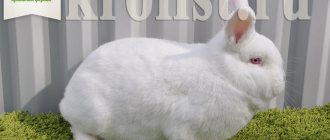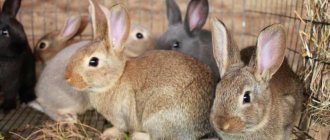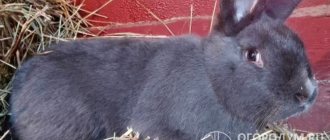The Belgian giant (Flanders, German Risen, Obr, Flemish giant) is the largest breed of rabbit in the world. Rabbits of this breed have been known since the 16th century, when breeders in Belgium (province of Flanders) developed it as a result of many years of work. At the end of the 19th century, rabbits were brought to Germany under the name “Belgian Giant”.
After this, German breeders got involved in the work and for several decades selected rabbits based on size and weight, as well as exterior. In 1937, under the name “Deutsche Riesen”, the breed took on its modern form, but to this day work on improvement is being carried out, the exterior is being formed, new standards are being introduced, which all rabbit breeders without exception should strive for - this is the first step to obtain first place at international and international competitions. regional rabbit shows.
Flandre compares favorably with other breeds with a powerful and long, well-built body, powerful and strong limbs, long wide-open ears with a minimum length of 17 cm. The standard weight of a rabbit is 7-7.5 kg, but with good feeding and maintenance, the Belgian giant “goes away” for 10 kg.
For several years, we have been traveling to Europe several times a year to personally buy rabbits for our private farm Moryak. This article will focus on Flanders rabbits, which were imported from several European countries: Slovakia, Austria, Germany, Holland. Some rabbits are worth mentioning separately.
So in December in Germany at the European Show at Leipzig 2012 we were able to buy breeding rabbits with excellent ratings from well-known breeders. A male was taken from the famous Risen breeder from Austria - Johan Wechselberg - Wechselberger. With a score of 96.5 points. We met this breeder in 2011 at the international Rizen exhibition in the city of Weiden, when we took rabbits from him.
Also, in Leipzig, they took giant rabbits from the excellent collection of rabbit breeder Hegemann Hienz, with scores of 96.5 points.
We bought Risen gelb rabbits. From the breeder Irmler Timo. Score 96 points.
Another released gelb, taken at the Euroshow in Leipzig. From the breeder Renninghoff Johannes, in this collection of 4 rabbits, one female was awarded “European champion” Score 96 points
Two agouti males (96-96 points) from the breeder Knappe Manfred and in this collection there is a European champion.
Two white female Risen with scores of 96.5 and 97 points (winners).
On other trips we visited the farms of Ewald Kremer, Arnold Franz and many, many others.
In general, the rabbits on our farm are from the best breeders in Europe.
The male, brought from Holland, has gained weight well and is working well.
Starting this year, blue Flemish giants began to be imported from Holland. The photo shows a teenager
Origin and history of the breed
The exact history of the origin of the breed has not been established. According to scientists, the first representatives of this species appeared before our era. In the 19th century, a breed of Himalayan rabbits was developed in Great Britain, which were brought to Russia 100 years later. Local breeders improved the breed.
However, later, due to crossing with other species, ermine rabbits were divided into two species. Moreover, in Europe another breed is being bred, which also belongs to this type of animal. Russian rabbits are inferior to Western ones in the quality of fur and meat. This is explained by the fact that breeders crossed this breed with a white giant. As a result, the animals' fur has lost its original thickness.
Agouti color
Agouti color - ambiguity of perception
I don’t know why, but I wanted to write about this color. Probably just because I love him very much (it’s not for nothing that I chose him for the logo of my nursery) I want to express my personal opinion. And also because this color today, in my opinion, is undeservedly not popular, people stereotypically prefer the “cheerful” spotted color. No, I have nothing against him and I myself deal with such rabbits, but I still hope that my article will give an opportunity to take a fresh look at agouti-colored rabbits. However, first, a little theory, where would we be without it? Everyone knows what we are talking about, but probably not everyone realizes that this is not only color, but also the so-called coat pattern, which is directly related to the genetic formula of a particular rabbit. All domestic rabbits in this regard are divided into three groups:
Description and characteristics of Russian ermine rabbits
Rabbits of this breed are distinguished by the following features:
- dense and muscular body, the average length of which is 51-52 centimeters;
- elastic chest with a wide girth in the scapular region;
- compact head with erect ears;
- average weight reaches four kilograms;
- males are larger than females;
- good down.
Ermine rabbits have a strong build. However, because of this, animals require a constant supply of microelements and vitamins.
Caring for a rabbit during the molting period
With proper care for your rabbit, the molting period will pass quickly and unnoticed. The animal must be brushed regularly. Rabbits are taught the process from an early age so that the animal does not panic. When changing fur, you should not change your usual food or mix it with food from another manufacturer. There is no need to bathe the rabbit or change its conditions.
During shedding, the animal can swallow fur, which subsequently leads to the formation of bezoars in the stomach. This will cause painful discomfort for the rabbit and cause constipation. The animals are very clean and constantly lick themselves.
Reference! For combing, it is better to use a special brush or collect hairs with wet hands.
To prevent improper functioning of the stomach and intestines, the rabbit must be monitored. At the first symptoms of constipation, the animal needs help. The rabbit has not gone to the toilet or eaten anything for 12 hours, this may be a symptom of an obstruction. Also, a rabbit's depressed state may indicate problems. A rounded belly from gases, feces of a smaller diameter or an unusual shape should alert pet owners.
If one or more symptoms appear, it is necessary to give him a massage and also give him vegetable oil, no more than 2-3 ml. Give your rabbit water more often during the day. If the animal refuses to drink, it is necessary to administer a glucose solution subcutaneously. In pet stores and veterinary pharmacies, purchase a special paste that prevents the formation of bezoars in the stomach.
Rules of maintenance and care
It is recommended to keep rabbits in cages measuring 60x65x60 centimeters or more. Each such dwelling must be supplemented with a fenced walking area. During the warm season, cages should be taken out into fresh air. Animals should be kept indoors during winter.
The following are considered optimal living conditions for ermine rabbits:
- air temperature - 10-25 degrees;
- daylight hours - 12 hours;
- air humidity - 60-75%;
- absence of wind and drafts.
It is recommended to lay bedding made of straw or hay in the cage. Each adult requires a separate drinker and feeder. The animal's place of residence must be regularly cleaned and treated with an antiseptic.
A prerequisite for breeding this breed is daily combing and regular washing of the fur. In the first case, you need to use a fine-toothed metal brush. When washing, do not allow water to get into your ears and eyes.
In addition, these animals require vaccination and periodic examination by a veterinarian.
Middle breed group
This group was bred for home breeding and meat production. Medium types are easy to care for and do not require much space to maintain.
The main thing is that the room for rabbits is bright, warm and dry, with an area of approximately 3 square meters. When animals reach 3 months. age, then they must be seated in groups that are divided by gender.
Don't forget that these individuals love grass, vegetables and fruits. Not all breeds are suitable for breeding at home. And now let's look at their main types.
California rabbit
This breed was bred in the state of California, which is why the species received its name. Rabbits are valued for the quality of their meat and fur.
It is also an unpretentious individual that quickly gains weight.
- The color is white, and the ears, paws, and tail are black or dark brown. Eyes pink or red. Has short and thick legs.
- On average, a Californian grows up to 4.5 kg if fed ad libitum. Food should be varied, with the presence of protein.
- It is necessary for the animal to always have clean and fresh water. In winter, it is important to monitor the water temperature. Let them drink only warm liquids.
- This breed can easily tolerate any climate. And their maintenance does not require large cell sizes.
- The female has about 8 cubs in her litter, which she can feed on her own.
New Zealand white
This breed is classified as an industrial breed, as it produces the maximum amount of meat and skin. The white rabbit gains weight very quickly, which is why this breed is popular in the production of meat products.
They do not require much space to breed. This breed of rabbit gains 4-5 kg of live weight. Female rabbits are very fertile and can reproduce from as young as 5 months.
Their litter includes up to 10 rabbits, which the female can feed on her own.
Rex
This Belgian breed translates to "king". Their skin is very valuable, beautiful, with unusual colors.
Externally, Rexes resemble beavers. This breed has short and crooked whiskers and velvety fur. Rex grows up to 55 cm and gains weight up to 4.5 kg.
A rabbit can live in an apartment or in a private barn.
If you buy him as a pet, then do not forget that he has a restless character. Rex chews on everything that gets in his way.
This breed has high intelligence and can even be litter box trained or trained. He knows his nickname and listens to words.
Rex tolerates temperature changes well. In hot climates it is difficult for him, but at temperatures up to 25°C he feels comfortable.
The individual has low fertility; up to 6 rabbits are born in a litter, but they do not always survive until adolescence.
Diet and feeding
The diet depends on the season. But for full development and maintenance of vital functions, rabbits must be regularly given food that contains vitamins (vitamins B and E are the most popular), proteins, fats, carbohydrates and minerals. In summer, adults are recommended to be given wild and slightly dried herbs (tansy, yarrow and others). Daily volume - up to 1.5 kilograms. Rabbits should be given no more than 500 grams of grass per day.
Regardless of the season, the diet should be diluted:
- grass mixtures;
- root vegetables (carrots, corn and others);
- durum apples;
- dried potato greens;
- tree branches.
Branches are necessary for grinding ever-growing teeth. It is recommended to feed beets and carrots in small portions, as this food causes diarrhea. During the harvest period, dried vegetable tops can be introduced into the diet. In winter, up to half of the diet should consist of concentrated and combined feeds. In the off-season, you can dilute the diet with bone and fish meal, and dairy products.
Feed additives during the molting period
Shedding usually does not leave any consequences, but to prevent brittle hair, dandruff and the rapid growth of a new coat, you can take a supplement containing sulfur. For a rabbit, 0.01 g is enough. drug per day.
Reference! Sulfur should be present in the animal’s food during seasonal, age-related molting, as well as when pathological hair loss occurs.
In addition to pharmaceutical medications, there are natural supplements that can prevent the formation of hairballs in the stomach. Fiber fiber will help maintain normal stomach and intestinal function. Grass and tree leaves in dry and fresh form. Branches of birch, willow or ash contain valuable fiber for your pet.
How to choose a good rabbit
Ermine rabbits are confused with California rabbits. The difference between these varieties comes down to the fact that in the first the dark spots on the paws rise to the knee joint, in the second - to the tips.
To choose a good rabbit, you need to compare the appearance of the young animals with the exterior characteristics of the breed. The coat of purebred animals should be shiny and thick. You also need to pay attention to the absence of fleas and lice, ulcers and deep wounds, and white spots on the eyes. source
source
Story
The owner of the Himalayan rabbit showed in the pictures how her furry changes color. Users didn’t believe her, but we have evidence that this is the absolute truth!
A Reddit user under the nickname pinklady968 published two photos of her rabbit, in which the furry has different colors. Netizens did not immediately believe the girl, because it all smacks of deception.
“My rabbit's ears, nose, tail and paws change color in cold weather. The same rabbit in both pictures,” wrote pinklady968. Many did not believe her, because it looks like ordinary Photoshop, but there were biology experts who explained this extraordinary phenomenon. Himalayan rabbits have dotted coloration that changes depending on the weather. The furry body produces a pigment (protein) that folds correctly only at lower temperatures.
Moreover, the brightness of a rabbit’s spots also depends on the temperature at which it was bred. Most pet fluffies are raised in average temperatures, so they have spots on their nose and ears. But in a cold environment, these rabbits darken, and in a hot environment they become completely white.
Source
Interesting for you:
Rabbit colors
Agouti group
Colors of rabbits with zonal hair. Characteristic of the colors of rabbits found in the wild.
Steel
The surface color is uniform black and gray.
The entire body of the animal is covered with light gray spinous hair. Wedge in the back of the head[…] 0 comments27 Jan
Deilenar
The surface color is bright reddish brown and extends down the sides.
On the back there is stronger shading formed by black tips[…] 0 comments27 Jan
Arctic fox (black guard)
The surface color is white, slightly covered with a gray tint of medium intensity, this tint is caused by the dark ends of the hair, which are evenly […]
0 comments27 Jan
Blue chinchilla (squirrel)
The covering color looks like ash-gray with a bluish tint covered with a blue veil.
The veil is most pronounced on[…] 0 comments27 Jan
Chinchilla
The covering color looks like ash-gray with a bluish tint covered with a black veil.
The veil is most pronounced[…] 0 comments27 Jan
Lux
The color is light gray-blue with a silvery sheen on the surface of the body and a brownish-red tint in the intermediate zone of the hair,[…]
0 comments27 Jan
Chocolate Agouti
The surface color is intensely pale brown with dark brown streaks.
The surface color and its shades should extend evenly[…] 0 comments27 Jan
Blue agouti (opal)
The surface color is blue-gray in light, medium and dark shades.
A medium shade is preferred. Belly color and lower tail[…] 0 comments27 Jan
Hare agouti
The cover color is brighter, reddish-brown with gray shading of the transitional coat, spreading down the sides.
On[…] 0 comments27 Jan
Agouti
The surface color is intense gray-brown with black dashes.
The surface color and its shades should extend evenly[…] 0 comments27 Jan
Group Solid
A group of animals with the same color fur all over their body
White red-eyed or blue-eyed
The color has a good shine, pure, white and spreads without any tint throughout the body, head and ears, belly[…]
0 comments27 Jan
Lilac
The covering color is light blue with a brown tint.
The color of the belly is duller. Eyes bluish-gray with ruby[…] 0 comments27 Jan
Chocolate (Havanna)
Rich dark brown with good shine.
The more saturated the color, the better. The eyes are brown, with a ruby shine,[…] 0 comments27 Jan
Blue
The covering color is from deep blue to dark blue with good gloss.
The eyes are bluish-gray, the claws are dark.[…] 0 comments27 Jan
Black
The body color is deep black and shiny.
The eyes are dark brown, the claws are brown to black.[…] 0 comments27 Jan
Tan group (tans)
A group of rabbits with dark tops and light bottoms
Seal Fox
Body color - see the description of the color of the forces.
Recognized in black, blue.[…] 0 comments27 Jan
Marder Fox
Body color – see description of marder color.
Recognized in black, blue.[…] 0 comments27 Jan
Fox
The color of the body is deep and shiny.
Recognized in black, blue, chocolate and lilac.[…] 0 comments27 Jan
Otter
Recognized in black, blue, chocolate and lilac colors.
Covering color of the body, head, ears, paws and[…] 0 comments27 Jan
Tang
The nostrils and the edge of the jaw have a clear border.
Even, not too wide dark circles around the eyes[…] 0 comments27 Jan
Point group (with markings)
Colors with darker markings on the head, ears, legs, and tail.
Fox Russian
General appearance: white with black points and red eyes.
The main background of the body is white.[…] 0 comments06 Feb
Fox Siamese
The color should be a rich dark brown (almost black) in the nose area (the spot should extend from[…]
0 comments06 Feb
Salander
The color of the body surface is light cream and covered with a thin, soot-like coating from light to medium[…]
0 comments27 Jan
Separator
The markings are similar to those of the Thuringian color, but less pronounced.
The main background is sand with a lilac tint,[…] 0 comments27 Jan
Isabella
Markings like those of the Thuringian color.
The main background of the body is light ocher with a blue tint, markings[…] 0 comments27 Jan
Thuringian chocolate
The ideal covering color is a combination of yellow-orange with darker outer tips, which are uniformly distributed like soot[…]
0 comments27 Jan
Thuringian
The ideal covering color is a combination of yellow-red-brown with dark outer tips, which, like soot, evenly cover[…]
0 comments27 Jan
Russian
Recognized in black, blue, chocolate versions.
The body is white. The head drawing consists of a mask and colored[…] 0 comments27 Jan
Siamese
Recognized in black, blue, chocolate versions.
The shoulders are slightly darker. Eye color is brown or gray,[…] 0 comments27 Jan
Frosty
The covering color looks like ash-gray with a bluish tint covered with a brownish veil.
The veil is most pronounced on[…] 0 comments27 Jan
Marder
Recognized in black, blue and chocolate colors.[…]
0 comments27 Jan
Group Yellow
Rabbits that are colored in yellow and red tones of varying intensities and shades
Cream otter
Pattern similar to the Thuringian color.
The main background of the body is sandy-cream, the markings are gray-blue.[…] 0 comments06 Feb
Cream
The covering color is yellow-cream with a cool tint.
Should spread evenly over the entire visible area of the body.[…] 0 comments27 Jan
Yellow Otter
The main background of the body is reddish in color, the undercoat is lighter.
Belly, inner side of paws, undertail, inner side[…] 0 comments27 Jan
Red
Covering color is deep red, with good shine.
The edging of the eyes, the edging of the jaws, the color of the belly, the inside of the paws[…] 0 comments27 Jan
Deer
The covering color is gray-yellow, with black tipping evenly distributed throughout the body.
Color on the belly[…] 0 comments27 Jan
Yellow
Covering color is dark yellow, with good shine.
Should spread evenly over the entire visible area of the body.[…] 0 comments27 Jan
Group Spotted
Colors with a colored pattern on a white background
Pied (butterfly)
The color consists of a colored pattern on a white background.
The pattern on the left side of the rabbit is symmetrical to the pattern[…] 0 comments05 Feb
Hotot
The eyes are framed by two narrow black circles 3-5 mm wide.
They cover the eyes continuously and of equal width. Eyelids[…] 0 comments05 Feb
Cheetah
Recognized in black-yellow, yellow-blue, chocolate-yellow, lilac-yellow, black-cream, blue-cream, chocolate-cream, lilac-cream combination.[…]
0 comments05 Feb
Raincoat
The head, including the area of the crown and ears, should be colored with the base color.
On the forehead should[…] 0 comments05 Feb
Spotted
The spotted color may be present on any recognized color in combination with white.
Colored parts of the color[…] 0 comments05 Feb
Dutch
The colored area of the design covers the jaws, back of the head and ears.
It starts from the tips of the ears, covers the head[…] 0 comments05 Feb
White-eared
The white-eared gene is dominant, when one copy of the gene is present, it is as in the picture, two[…]
0 comments24 Feb
Silver group
Uniform mixture of white and colored hairs on the rabbit's body
Silver light
The mixture of white and colored hairs creates a special coat color[…]
0 comments06 Feb
Not recognized colors
Colors that do not have official recognition and standards in the SZS
White-breasted (unrecognized color)
The colored body, paws and part of the belly are white.[…]
0 comments06 Feb
Siamese lilac (not recognized color)
Pearly white body[…]
0 comments06 Feb
Pink Siamese (not a recognized color)
The body is almost white with a slight brownish-pinkish tipping, which is more intense on the back, the sides are almost […]
0 comments06 Feb
Masquerade (not recognized color)
An asymmetrical white pattern on a colored background[…]
0 comments06 Feb
Van, Charlie (not recognized color)
White body and head, ears and areas around the eyes are colored on the head[…]
0 comments06 Feb
Causes of hair loss
There are two types of reasons why rabbits lose hair:
The physiological reason includes molting - a natural and necessary process for the normal functioning of animals. Pathological causes are diseases whose side effect is hair loss.
It is not difficult to distinguish natural shedding from a serious disease. With the natural change of coat after hair loss, new thick and healthy hair begins to emerge after a short time. If new hair does not grow back and a bald spot remains, then this is a reason to contact a veterinarian.
Reproduction of the humpback hare
Agouti's marital fidelity can sometimes be envied. Having formed a pair, the animals remain faithful to each other until the end of their lives . The male is responsible for the safety of the female and her offspring, so he does not mind once again demonstrating his own strength and courage in the fight against other males. Such battles occur especially often during the period of choosing a life partner.
The female humpback hare gives birth to litters twice a year. The gestation period is a little more than a month, after which no more than four developed and sighted hares are born. After living for some time near their parents, the grown and strengthened animals create their own families.
Return to content
Knitted fur
In fact, knitted fur is a special fur yarn from which fur products are made that are extremely similar in quality and appearance to knitted items.
The patent for the invention of knitted fur belongs to Paula Lishtman, who until the end of the last century carefully hid the secret of making fur “yarn.” To work, take the largest large rabbit skins (beaver, mink), pluck them, after which a thin long continuous thread is cut out of the skin in a spiral, which is twisted into a ball. The process, of course, does not stop there. Next, the base of their cotton thread is created, the so-called mesh of the product, onto which the finest fur thread is “tied”. The fur knitwear obtained in this way is soft not only on the outside, but also on the inside, since the fur thread is twisted and its fluffy side is located both outside the product and partially inside. Sweaters, light jackets, suits using knitted fur technology were “painted” with rhombuses and openwork patterns, that is, with all the attributes of knitted products. Knitted fur items are durable, suitable for everyday wear, practical, and at the same time completely unique, since you can choose a new pattern each time to create them. Such stylish items are suitable for a business reception, but it is also convenient for an ordinary country trip, and those who have items made of knitted fur sometimes consider them a “second skin” because of their plasticity, lightness and extraordinary softness.
Black-fire
The direct descendants of this breed are the hare and the wild rabbit.
Namely, they inherited their aggressiveness to the black-fire ones. Although, recently, after long crossings, this character trait of animals has softened a little. The breed was first mentioned in 1880 in England. The main difference between these rabbits is their beautiful appearance. The combination of beautiful fur and proper physique produces a spectacular spectacle. The body of the animal is wide and oval. The back is straight. Strong and strong paws. The head is proportional to the body, with beautiful erect ears. The color of the back is black, and the belly is fiery. Due to its beautiful color, this fur goes into production without pre-dyeing. Namely, it constitutes the main value of the breed.
Most often, the weight of an adult is 3.5 kg. This is a relatively good indicator, but still, the breed can hardly be called a meat-skin breed. It is easier to classify it as downy.
How does normal shedding occur?
Normal shedding in rabbits is usually unnoticeable, but can be scary for breeders. This is because normal shedding can have many variations and manifestations.
| Shedding type | Peculiarities |
| Inconspicuous | In this case, the hair falls out visually imperceptibly, in small pieces. |
| Sudden appearance of bald spots | The appearance of bald spots does not indicate the presence of a pathology if the skin remains clean, dry and untouched in the bald areas. The animal has an unusual appearance with bald patches that extend along the back and sides. |
| Fast | Your rabbit will shed very quickly and its fur will fall out in large clumps. Within 10-14 days you can see a completely restored rabbit fur coat. |
| Excessive | Replacement of wool is delayed in time, there are no breaks, bald spots in the wool are constantly noticeable. This condition is usually caused by metabolic disorders in the body and has many causes related to nutrition: 1) The manifestation of food allergies. 2) Sudden and frequent changes in food products. 3) Feeding with high-protein foods (clover, alfalfa, legumes). When a normal diet is introduced, allergens are eliminated and all feeding recommendations are followed, the coat stops shedding. The animal sheds a lot even in case of age-related changes. In this case, it is impossible to help, and the only way out is to support the animal’s immunity (pay more attention to coat care, diversify the diet with vitamins). |
Population and species status
The number of hares is regulated naturally . Approximately every twelve years, outbreaks of mass reproduction of hares are observed, as a result of which the number of damaged trees and shrubs increases significantly. And then the natural mechanism of population regulation kicks in - the number of predators also increases. As a result, the number of animals is decreasing. Hunters and local farmers who suffer from Agouti raids on sugar cane plantations “help” predators regulate this process.
This is interesting! In addition, the number of agouti is declining due to the reduction of its habitat. This occurs due to the expansion of human economic activity. Therefore, some species of Agouti are listed in the Red Book.
Return to content
Appraisal
The main goal of grading is to determine the quality of rabbits, taking into account their development indicators, breed and other indicators. The procedure involves examining the animals and making appropriate zootechnical records. Booting is carried out annually on farms that raise rabbits on a production scale.
Booting is the main way to evaluate young animals according to the parameters of the elite class.
The livestock is divided into two groups: selection and custom herd. The former are used to produce replacement young stock, and the latter to produce breeding stock. Males and females of the main herd, one-time females at the end of autumn, and all three-month-old young animals of the selection group are subject to grading.
Diseases and infections requiring treatment
If molting in rabbits is a normal process, then it happens that hair loss is caused by various diseases and the presence of parasites on the animal’s body:
- Ringworm. Caused by microscopic fungi. The disease is contagious. Characteristic signs are the presence of limited areas of skin without hair. There are red spots and irritation on the skin. Treatment is carried out by administering a vaccine.
- Fleas. Such parasites can be transmitted from dogs and cats. When allergies occur, hair begins to fall out. In addition, they can cause such a serious disease as myxomatosis.
- Ticks. Various types of mites parasitize not only on and under the skin itself, but also in hair follicles.
- Dermatosis. Otherwise called skin fungus. Severe itching appears, hair begins to fall out around the ears. It is treated with antifungal ointment, which is applied to problem areas.
- Hormonal imbalance. Determined by a blood test.
- Avitaminosis. Occurs when there is a lack of vitamins in the body. It is necessary to strengthen their diet. The fur and skin of animals requires vitamins A, E, B12, nicotinic acid, and sulfur.
Vitamin deficiency can be prevented by following the recommendations indicated in the table:
Treatment must be prescribed by a veterinarian. For accurate diagnosis, the following samples are taken:
- UAC and BAK. These blood tests determine the presence of vitamin deficiency and micronutrient deficiencies. Show the presence of an inflammatory process.
- Scraping Determines the presence of fungi and parasites.
- Hair analysis. It will show what exactly led to their destruction and loss.
Diagnostics can reveal the causes of bald patches in rabbits.
Natural enemies
Agoutis run very fast, covering distances in leaps and bounds. The jump length of this hare is about six meters. Therefore, despite the fact that the humpback hare is a desirable prey for hunters, it is very difficult to catch it.
Agouti's worst enemies are Brazilian dogs, wild cats and, of course, humans. But thanks to good hearing, as well as a keen sense of smell, hares are not easy prey for both predators and hunters. Agouti's only drawback is poor eyesight.
Return to content
When do decorative rabbits shed?
Domestic ornamental rabbits are subject to the same molting stages as farmed rabbits. The only difference is that for apartment rabbits the process can take a long time, moving from one type of molting to another without interruptions. Therefore, proper coat care is important for domestic rabbits during such a delicate period.
What to do during the molting period?
- Periodically comb long-haired dwarf eared cats to prevent the formation of tangles (once every 2-3 days).
- Constantly stroke short-haired pets with a dampened palm.
- Clean the cage daily.
- Make sure that hairballs do not accumulate in the stomach of your decorative pet.
Genes and chromosomes
Sets of genes that give certain characteristics are located in long DNA molecules - chromosomes. In each of them, genes are located in specific locations called loci. Some loci may carry several types of genes, while others may carry only one. Each chromosome is associated with another sequence of the same type, with genes located at the same loci.
Chromosomes and genes always exist in pairs; there are 22 different pairs of chromosomes in each cell of the body. The only exceptions are germ cells and red blood cells.
The same locus on each paired chromosome controls the same trait. In other words, each trait requires a pair of genes to manifest.
Some genes are completely identical to their pair and are called homozygous . Others are different from each other and are called heterozygous .
Why does a rabbit breeder need knowledge about wild rabbits?
Domesticated breeds of rabbits, despite the artificial method of cultivation, were able to preserve their primitiveness and not forget their natural instincts. But for proper care and recognition of natural needs, rabbit breeders must know the developmental features of wild relatives. Such knowledge will help to properly organize the necessary living conditions and life of the animals.
Rabbit-human interaction
For people, rabbits are primarily a source of dietary meat and valuable skins. In recent years, decorative rabbits have also become popular, making them excellent pets. Animals bring great benefits to science. They are used as laboratory animals on which new drugs and food products are tested. Genetic studies and experiments are often carried out on eared animals.
Video Journey to the animal kingdom.
Genes in reproduction
In the germ cells - the egg and the sperm - there is only one chromosome from a pair. When the egg is fertilized, these single chromosomes are united, and a full pair is formed again. So it turns out that in the new organism one chromosome is represented from the father, and the other from the mother. Their external manifestation in a baby rabbit depends on the dominance relationships of these genes, as well as on the action of other genes or modifiers.
Excessive shedding
If your rabbit's hair loss is severe and constant, and permanent bald patches appear on its body, change its diet and limit excess food in your pet's diet.
Excessive hair in rabbits can also be a result of frequent food changes. Pick one food and try not to change it to quickly figure out what is causing your health problem.
It is possible that the dwarf rabbit sheds a lot due to excess protein in the feed. Check the composition of the rabbit food, 15-16% protein is enough.
Another reason for excessive shedding is the age of the rabbit. The older the animal, the more intense the shedding will be.
Feeding characteristics, Agouti production
Humpback hares are herbivores. They feed on leaves, as well as flowers of plants, tree bark, roots of herbs and shrubs, nuts, seeds and fruits.
This is interesting! Thanks to its strong and sharp teeth, Agouti can easily cope with even hard Brazilian nuts, which not every animal can do.
It is very interesting to watch agoutiformes eat. They sit on their hind legs, grab food with the tenacious fingers of their forelimbs and put it into their mouth. Often, hares of this species cause significant damage to farmers, wandering onto their lands to feast on bananas and sweet reed stalks.
Return to content
